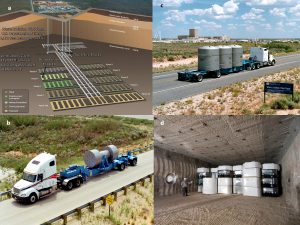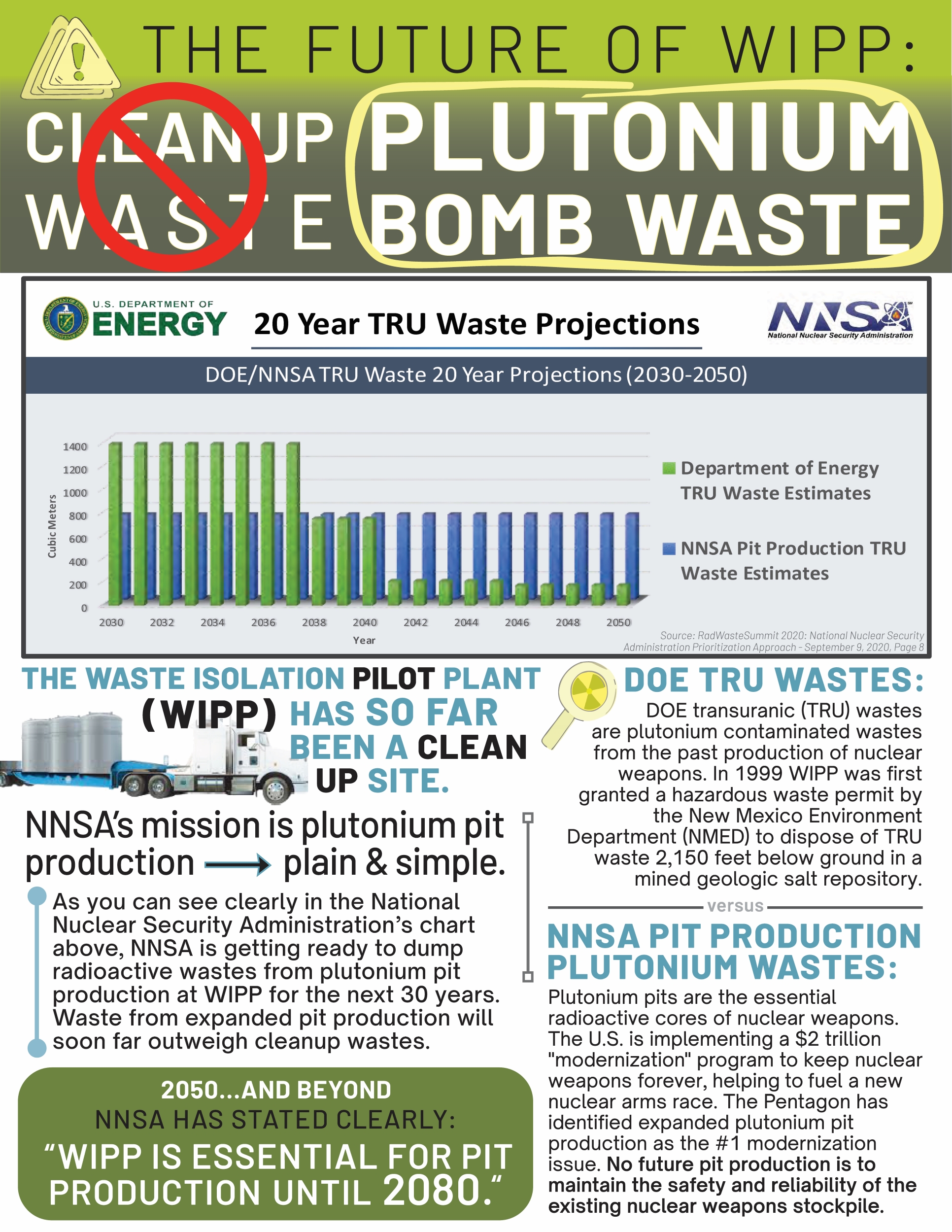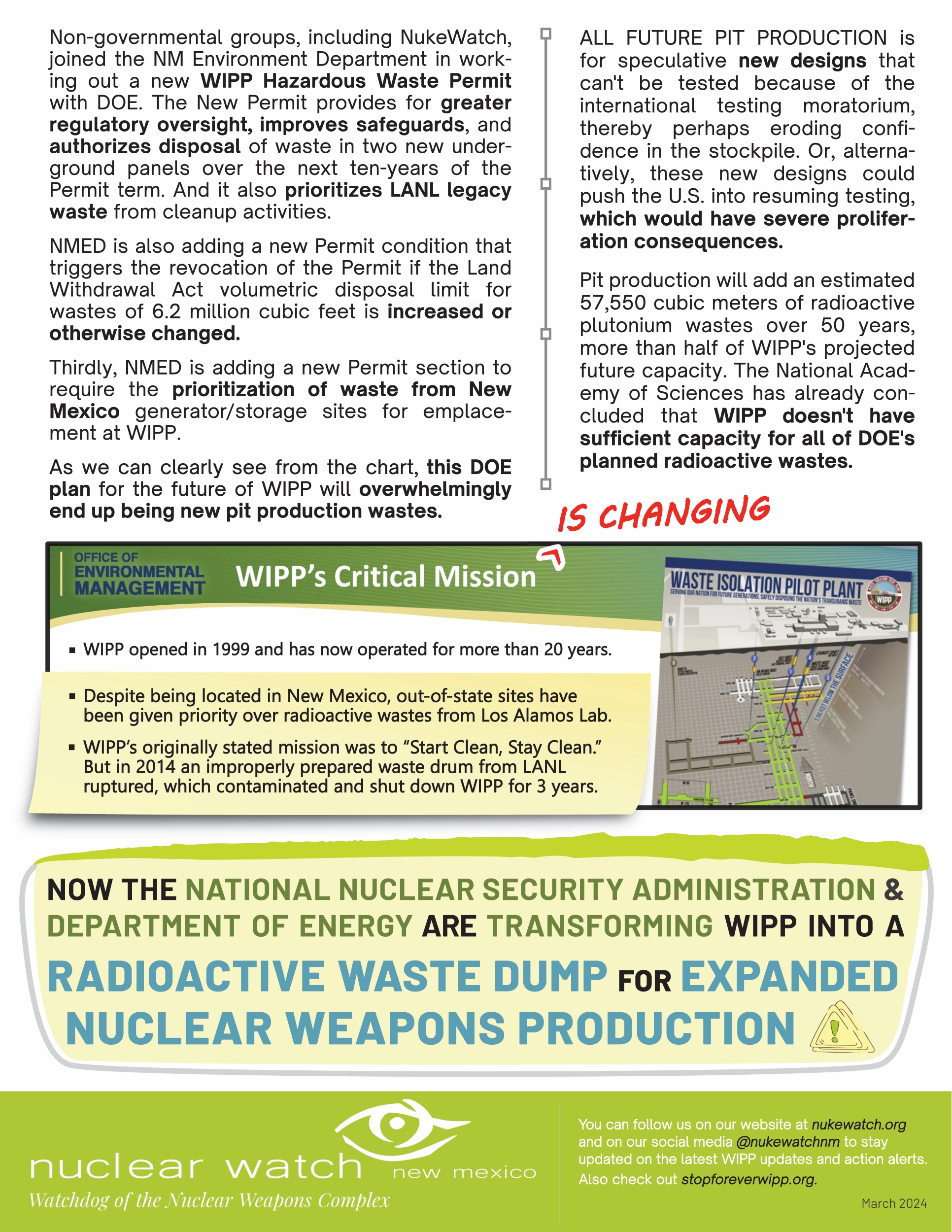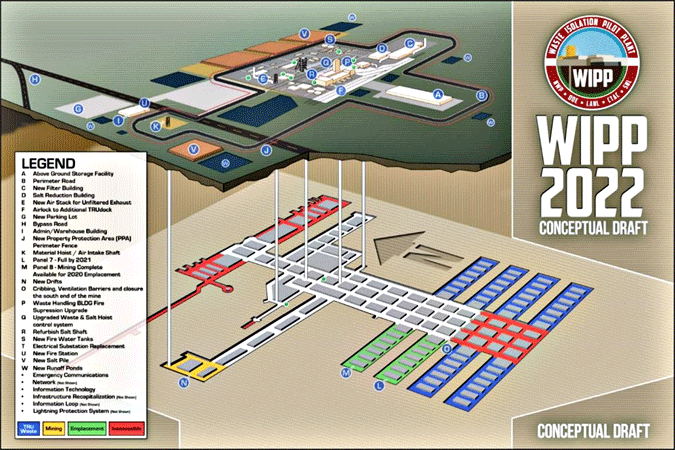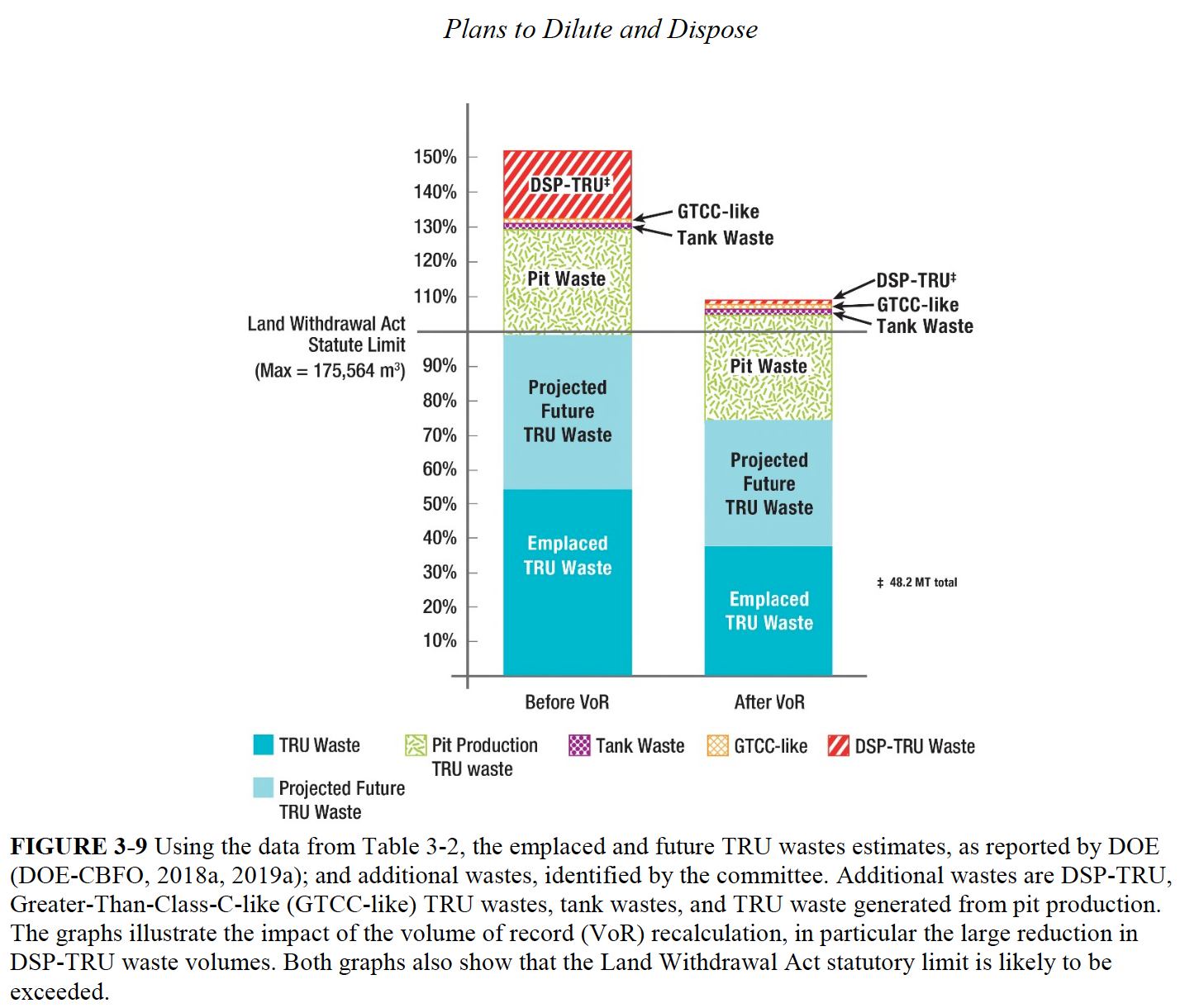Description and Current Mission
The Waste Isolation Pilot Plant (WIPP) is the nation's only deep geologic long-lived radioactive waste repository. Located 26 miles southeast of Carlsbad, New Mexico, the WIPP repository is mined within a 2,000-foot-thick bedded-salt formation. The Underground (U/G) is 2,150 feet beneath the ground surface. WIPP was constructed to determine the efficacy of an U/G repository for disposal of transuranic (TRU) waste. Disposal operations began in 1999 and are scheduled to continue for 35 years. WIPP was constructed for disposal of defense-generated TRU waste from DOE sites around the country. TRU waste consists of clothing, tools, rags, residues, debris, soil and other items contaminated with small amounts of plutonium and other man-made radioactive elements. The waste is permanently disposed of in rooms mined in an underground salt bed layer over 2000 feet from the surface.
TRU waste began accumulating in the 1940s with the beginning of the nation's nuclear defense program. As early as the 1950s, the National Academy of Sciences recommended deep disposal of long-lived TRU radioactive wastes in geologically stable formations, such as deep salt beds.
TRU waste is categorized as "contact-handled" or "remote-handled" based on the amount of radiation dose measured at the surface of the waste container. Contact-handled waste has a radiation dose rate not greater than 200 millirem (mrem) per hour, while remote-handled waste can have a dose rate up to 1,000 rem per hour. About 96 percent of the waste to be disposed at WIPP is contact-handled.
TRU waste is long-lived and has to be isolated to protect public health and the environment.
Four shafts connect the U/G area with the surface. The Waste Shaft headframe and hoist are located within the Waste Handling Building and are used to transport TRU mixed waste, equipment, and materials to the repository. The Waste Hoist can also be used to transport personnel and materials. The Air Intake Shaft (AIS) and the Salt Handling Shaft provide ventilation to all areas of the U/G except for the Waste Shaft station. This area is ventilated by the Waste Shaft itself. The Salt Handling Shaft is also used to hoist mined salt to the surface and serves as the principal personnel transport shaft. The Exhaust Shaft serves as a common exhaust air duct for all areas of the U/G.
History of WIPP
Throughout the 1960s, government scientists searched for an appropriate site for radioactive waste disposal, eventually testing a remote desert area of southeastern New Mexico where, 250 million years earlier, evaporation cycles of the ancient Permian Sea had left a 2,000-foot-thick salt bed.
DOE was authorized by Public Law 96-164, Department of Energy National Nuclear Security and Military Applications of Nuclear Energy Authorization Act of 1980, to provide a research and development facility for demonstrating the safe, permanent disposal of TRU wastes from national defense activities and programs of the United States exempted from regulations by the U.S. Nuclear Regulatory Commission.
Congress limited WIPP to the disposal of defense-generated TRU wastes in the 1992 Land Withdrawal Act. In 1998, the U.S. Environmental Protection Agency certified WIPP for safe, long-term disposal of TRU wastes.
On March 26, 1999, the first waste shipment arrived at WIPP from Los Alamos National Laboratory in New Mexico.
The WIPP Land Withdrawal Act, Public Law 102-579, as amended by Public Law 104-201, authorized the disposal of 6.2 million cubic feet of defense TRU waste at the WIPP facility.
The WIPP facility operates in several regulatory regimes. DOE has authority over the general operation of the facility, including radiological operations prior to closure. The U.S. Environmental Protection Agency (EPA), through 40 Code of Federal Regulations (CFR) Parts 191 and 194, certifies the long-term radiological performance of the repository over a 10,000-year compliance period after closure of the facility. The State of New Mexico, through EPA delegation of the Resource Conservation and Recovery Act (RCRA), has issued a Hazardous Waste Facility Permit for the disposal of the hazardous waste component of the TRU waste. Additionally, the Mine Safety and Health Administration (MSHA) is required to perform four inspections per year of WIPP.
WIPP's disposal rooms are nearly a half mile below the surface (2,150 feet). By comparison, the Empire State Building is only 1,454 feet high.
Browse this page to keep updated on NukeWatch and other local community group's efforts to STOP FOREVER WIPP
STAY INFORMED:
Endless Nuclear Waste Storage in NM?? Not On Our Watch…
Keep up with the Stop Forever WIPP Coalition to learn how to take action against the Federal Government’s Plan to Expand WIPP and keep it open indefinitely.
Visit the Stop Forever WIPP Coalition’s website and social media:
Website: www.StopForeverWIPP.org
Facebook: facebook.com/StopfvrWIPP
Twitter: twitter.com/stopforeverwipp
Instagram: instagram.com/stopfvrwipp
Stay Informed of All Permit-Related Happenings at WIPP! Sign Up for Updates:
The New Mexico Environment Department maintains a Facility Mailing List to which you can add your name and address to get the latest information – just email Ricardo Maestas at the New Mexico Environment Department at ricardo.maestas@state.nm.us and ask to be added to the list. Or mail your request with your mailing address to:
Continue reading→
WIPP News & Updates
Nothing Found
It seems we can’t find what you’re looking for. Perhaps searching can help.
STOP FOREVER WIPP! Specific News to WIPP Closing Plans
Nothing Found
It seems we can’t find what you’re looking for. Perhaps searching can help.
Video Presentation on WIPP Expansion - February 5, 2022
Resources & Media
Nothing Found
It seems we can’t find what you’re looking for. Perhaps searching can help.
National Academy of Scientists Report
Review of the Department of Energy's Plans for Disposal of Surplus Plutonium in the Waste Isolation Pilot Plant 2020
Action Alerts
Nothing Found
It seems we can’t find what you’re looking for. Perhaps searching can help.
Quotes
Nothing Found
It seems we can’t find what you’re looking for. Perhaps searching can help.

